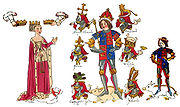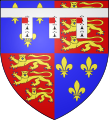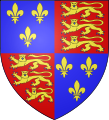
Richard III of England
Background to the schools Wikipedia
SOS Children has tried to make Wikipedia content more accessible by this schools selection. With SOS Children you can choose to sponsor children in over a hundred countries
| Richard III | |
|---|---|
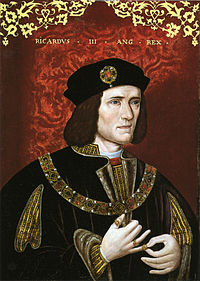 |
|
|
|
|
| Reign | 26 June 1483 – 22 August 1485 |
| Coronation | 6 July 1483 |
| Predecessor | Edward V |
| Successor | Henry VII |
| Consort | Anne Neville |
| Issue | |
| Edward of Middleham, Prince of Wales | |
| House | House of York |
| Father | Richard Plantagenet, Duke of York |
| Mother | Cecily Neville |
| Burial | Greyfriars Abbey, Leicestershire |
Richard III (2 October 1452 – 22 August 1485) was King of England from 1483 until his death. He was the last king of the House of York and the Plantagenet dynasty. His defeat at the Battle of Bosworth Field was the decisive battle of the Wars of the Roses, and is sometimes regarded as the end of the Middle Ages in England. He is the central character of a well-known play by William Shakespeare.
After the death of his brother King Edward IV, Richard briefly governed the country on behalf of Edward's son King Edward V, but then seized the crown himself. Edward and his brother Richard (known as the Princes in the Tower) seem to have disappeared shortly afterwards; there is a good deal of dispute over their alleged murder by Richard.
Two large-scale rebellions rose against Richard. The first, in 1483, was led by staunch opponents of Edward IV and, most notably, Richard's own ' kingmaker', Henry Stafford, 2nd Duke of Buckingham. The revolt collapsed and Buckingham was executed at Salisbury, near the Bull's Head Inn. However, in 1485, another rebellion arose against Richard, headed by Henry Tudor, 2nd Earl of Richmond (later King Henry VII) and his uncle Jasper. The rebels landed troops and Richard fell in the Battle of Bosworth Field, the last English king to die in battle.
Childhood
Richard was born at Fotheringhay Castle, the eighth and youngest child, and fourth surviving son of Richard Plantagenet, 3rd Duke of York (who had been a strong claimant to the throne of King Henry VI) and Cecily Neville. Richard spent several influential years of his childhood at Middleham Castle in Wensleydale, under the tutelage of his cousin Richard Neville, 16th Earl of Warwick (known as "The Kingmaker" because of his strong influence on the course of the Wars of the Roses). While Richard was at Warwick's estate, he developed a close friendship with Francis Lovell, a friendship that would remain strong for the rest of his life. Another child in the household was Warwick's daughter Anne Neville, whom Richard would later marry.
At the time of the death of his father and older brother Edmund at the Battle of Wakefield, Richard, who was eight years old, was sent by his mother, the Duchess of York, to the Low Countries, beyond the reach of Henry VI's vengeful Queen, Margaret of Anjou. He was accompanied by his elder brother George (later Duke of Clarence). They returned to England following the defeat of the Lancastrians at the Battle of Towton, and participated in the coronation of Richard's eldest brother as King Edward IV. At this time, Richard was named Duke of Gloucester as well as being made a Knight of the Garter and a Knight of the Bath. Richard was then sent to Warwick's estate at Middleham for his knightly training. With some interruptions, Richard stayed at Middleham until early 1465, when he was 12.
Richard became involved in the rough politics of the Wars of the Roses at an early age. Edward appointed him the sole Commissioner of Array for the Western Counties in 1464, when he was 11. By the age of 17, he had an independent command.
At a second time in his youth Richard was forced to seek refuge in the Low Countries which were part of the realm of the Duchy of Burgundy. His sister Margaret had become the wife of Charles the Bold, Duke of Burgundy in 1468. Richard along with his brother, the King, fled to Burgundy in October 1470 after Warwick defected to the side of Margaret of Anjou. Only 18 years old, Richard played crucial roles in two battles which resulted in Edward's restoration to the throne in spring 1471 — Barnet and Tewkesbury.
| English Royalty |
|---|
| House of York |
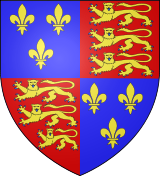 |
| Richard Plantagenet, 3rd Duke |
| Anne, Duchess of Exeter |
| Edward IV |
| Edmund, Earl of Rutland |
| Elizabeth, Duchess of Suffolk |
| Margaret, Duchess of Burgundy |
| George Plantagenet, 1st Duke of Clarence |
| Richard III |
| Richard III |
| Edward of Middleham, Prince of Wales |
Reign of Edward IV
During the reign of his brother, King Edward IV, Richard demonstrated his loyalty and skill as a military commander. He was rewarded with large estates in northern England, and appointed as Governor of the North, becoming the richest and most powerful noble in England. In contrast, their other surviving brother, George Plantagenet, 1st Duke of Clarence, fell out with Edward and was executed for treason.
Richard controlled the north of England until Edward IV's death. There, and especially in the city of York, he was regarded with much love and affection. In 1482 Richard recaptured Berwick-upon-Tweed from the Scots, and his administration was regarded as fair and just. Richard and his wife Anne endowed universities and made grants to the church.
Accession to the Throne
On the death of Edward IV, on 9 April 1483, the late King's sons (Richard's nephews), King Edward V, aged 12, and Richard, Duke of York, aged 9, were next in the order of succession. Richard, however, had the king's guardians - including Elizabeth's brother Anthony Woodville, 2nd Earl Rivers - arrested and taken to Pontefract Castle, where they were later executed, allegedly for planning to assassinate Edward V. He then took Edward and his younger brother to the Tower of London.
On 22 June 1483, outside St. Paul's Cathedral, a statement was read out on behalf of Richard declaring that Edward IV's marriage to Elizabeth Woodville was illegitimate and that, in consequence, Richard, not his nephew, was the rightful king.
Parliament then passed the Titulus Regius in support of Richard, on the evidence of a bishop who testified to having married Edward IV to Lady Eleanor Butler, who was still living when Edward married Elizabeth Woodville. On 6 July 1483, Richard was crowned at Westminster Abbey.
The young princes were never seen again. Although Richard III is widely believed to have killed Edward V and his brother, there is considerable controversy about the actual circumstances of the boys' deaths: see Princes in the Tower.
Death at the Battle of Bosworth
On 22 August 1485, Richard met the Lancastrian forces of Henry Tudor at the Battle of Bosworth Field. He was astride his white courser. The size of Richard's army has been estimated at 8,000, Henry's at 5,000, but exact numbers cannot be known. During the battle Richard was abandoned by Lord Thomas Stanley, 1st Earl of Derby, Sir William Stanley, and Henry Percy, 4th Earl of Northumberland. The switching of sides by the Stanleys severely depleted the strength of Richard's army and had a material effect on the outcome of the battle. Also the death of John Howard, Duke of Norfolk, his close companion, appears to have had a demoralising effect on Richard and his men. Accounts note that Richard fought bravely and ably during the battle, unhorsing Sir John Cheney, a well-known champion, killing Henry's standard bearer Sir William Brandon and nearly reaching Henry himself before being finally surrounded and killed. Tradition holds that his final words were " treason, treason, treason, treason, treason".
Polydore Vergil, Henry Tudor's official historian, would later record that "King Richard, alone, was killed fighting manfully in the thickest press of his enemies". Richard's naked body was then exposed, possibly in the collegiate foundation of the Annunciation of Our Lady, and hanged by Henry Tudor, now King Henry VII, before being buried at Greyfriars Church, Leicester. In 1495 Henry VII paid £50 for a marble and alabaster monument. According to one tradition, during the Dissolution of the Monasteries his body was thrown into the nearby River Soar, although other evidence suggests that a memorial stone was visible in 1612, in a garden built on the site of Greyfriars. The exact location is now lost due to over 500 years of subsequent development. There is currently a memorial plaque on the site of the Cathedral where he may have once been buried.
According to another tradition, Richard consulted a seer in the town of Leicester before the battle who foretold that "where your spur should strike on the ride into battle, your head shall be broken on the return." On the ride into battle his spur struck the bridge stone of the Bow Bridge; legend has it that, as his corpse was being carried from the battle over the back of a horse, his head struck the same stone and was broken open.
Richard was the last English king to be killed in battle. (Only one other was so killed, Harold Godwinson.)
Henry Tudor succeeded Richard to become Henry VII, and sought to cement the succession by marrying the Yorkist heiress, Elizabeth of York, Edward IV's daughter and Richard III's niece.
Succession
Following the decisive Yorkist victory over the Lancastrians at the Battle of Tewkesbury, Richard had married the younger daughter of the Earl of Warwick, Anne Neville on 12 July 1472. Anne's first husband had been Edward of Westminster, son of Henry VI.
Richard and Anne had one son, Edward of Middleham, who died not long after being created Prince of Wales. Richard also had a number of illegitimate children, including John of Gloucester, executed by King Henry VII, and a daughter named Katharine (d. 1487) who married William Herbert, 2nd Earl of Pembroke. It has been thought that their mother may have been one Katherine Haute, who is mentioned in household records. Both of these children survived Richard. It is not known whether or not they left any descendants. The mysterious Richard Plantagenet is also a possible offspring of Richard III as is Richard the Master- Builder .
At the time of his last stand against the Lancastrians, Richard was a widower without a legitimate son. After his son's death, he had initially named his nephew, Edward, Earl of Warwick, Clarence's young son and the nephew of Queen Anne Neville, as his heir. After Anne's death, however, Richard named as his heir another nephew, John de la Pole, Earl of Lincoln, the son of his older sister Elizabeth.
Legacy
Richard's death at Bosworth resulted in the end of the Plantagenet dynasty, which had ruled England since the succession of Henry II in 1154. The last male Plantagenet, Edward, Earl of Warwick (son of Richard III's brother Clarence) was executed by Henry VII in 1499.
Richard's Council of the North greatly improved conditions for Northern England, as commoners of that region were formerly without any substantial economic activity independent of London. Its descendant position was Secretary of State for the Northern Department.
Controversy and reputation
Much that was previously considered fact about Richard III has been rejected by modern historians. For example, Richard was represented by Tudor writers as being physically deformed, which was regarded as evidence of an evil character. However, the withered arm, limp and crooked back of legend are nowadays believed to be fabrications; the questionable history attributed to Thomas More made a deep impression upon William Shakespeare, and was long taken as the authoritative history of events. Shakespeare made Richard the subject of his play Richard III, which portrayed him negatively.
The Richard III Society was established in the 20th century and has gathered considerable research material about his life and reign. Its aim is summed up by its patron, the present Richard, Duke of Gloucester:
"… the purpose and indeed the strength of the Richard III Society derive from the belief that the truth is more powerful than lies - a faith that even after all these centuries the truth is important. It is proof of our sense of civilised values that something as esoteric and as fragile as reputation is worth campaigning for."
The Society of Friends of King Richard III was also set up in the 20th century in order to rehabilitate Richard's reputation and to honour his memory. The society is based in the city of York, where following his death in 1485 it was proclaimed, "King Richard, late reigning mercifully over us, was.... piteously slain and murdered, to the great heaviness of this city."
Richard III was found not guilty in a mock trial presided over by three justices of the United States Supreme Court in 1997. Chief Justice William H. Rehnquist and Associate Justices Ruth Bader Ginsberg and Stephen G. Breyer, in a 3-0 decision, ruled that the prosecution had not met the burden of proof that "it was more likely than not" that the Princes in the Tower had been murdered; that the bones found in 1674 in the Tower were those of the princes; or that Richard III had ordered or was complicit in their deaths.
Popular culture
Novelists Horace Walpole, Josephine Tey and Valerie Anand are among writers who have argued that Richard III was innocent of death of the Princes. Sharon Kay Penman, in her historical novel The Sunne in Splendour, also portrays Richard III as a just and honest ruler and attributes the death of the Princes to the Duke of Buckingham. In the mystery novel The Murders of Richard III by Elizabeth Peters (1974) the central plot revolves around the debate whether Richard III was guilty of these as well as other crimes. A sympathetic portrayal of Richard III is given in The Founding, the first volume in The Morland Dynasty, a series of historical novels by author Cynthia Harrod-Eagles.
Perhaps the best known film adaptation of Shakespeare's play Richard III is the 1955 version directed and produced by Sir Laurence Olivier, who also played the lead role. Also notable is the 1995 film version starring Sir Ian McKellen, set in a fictional 1930s fascist England, and Looking for Richard, a 1996 documentary film directed by Al Pacino, who plays the title character as well as himself. In the BBC series based on Shakespeare's history plays, An Age of Kings, Paul Daneman plays Richard.
In spite of having died at the age of 32, Richard is often depicted as being considerably older. Basil Rathbone and Peter Cook were both 46 when they played him, Laurence Olivier was 48 (in his 1955 film), Vincent Price was 51, Ian McKellen was 56, and Pacino also 56, in his 1996 film (although Pacino was 39 when he played him on Broadway in 1979 and Olivier was 37 when he played him on-stage in 1944).
In a play within a play in Neil Simon's 1977 film The Goodbye Girl, Richard Dreyfuss reluctantly portrays Richard as overtly homosexual at the insistence of an avant-garde director. Dreyfuss' performance won him the 1978 Academy Award for Best Actor.
In the television comedy series The Black Adder, Richard III is portrayed by Peter Cook in an alternative version of history as a doting, kindly man who treats the princes in the tower with affection. He is unintentionally killed by Edmund, the titular "Black Adder" ( Rowan Atkinson). His death leads, not to the crowning of Henry Tudor, but to the rule of Richard IV, who in the television series has grown up to be Edmund's father.
Titles, styles, honours and arms
Arms
As Duke of Gloucester, Richard had use of the coat of arms of the kingdom, differenced by a label argent of three points ermine, on each point canton gules. As sovereign, he had use of the arms of the kingdom undifferenced. His motto was "Loyaulte me lie," "Loyalty binds me."
Ancestry
| Ancestors of Richard III of England | ||||||||||||||||||||||||||||||||||||||||||||||||||||||||||||||||||||||||||||||||||||||||||||||||||||||||||||||||||||||||||||||||||||||||||||||||||||||||||||||||||||||||||||||||||||||||||||||||||||||||||||||||||||||||||||||||||||||||||||||||||||||||||||||||||||||||||||||||||||||||||||||||||||||||||||||||||||||||||||||||||||||||||||||||||||||||||||||||||||||||||||||||||||||||||||||||||||||||||||||||||||||||||||||||||||||||||||||||||||||||||||||||||||||||||||||||||||||||||||||||||||||||||||||||||||||||||||||||||||||||||||||||||||||||||
|---|---|---|---|---|---|---|---|---|---|---|---|---|---|---|---|---|---|---|---|---|---|---|---|---|---|---|---|---|---|---|---|---|---|---|---|---|---|---|---|---|---|---|---|---|---|---|---|---|---|---|---|---|---|---|---|---|---|---|---|---|---|---|---|---|---|---|---|---|---|---|---|---|---|---|---|---|---|---|---|---|---|---|---|---|---|---|---|---|---|---|---|---|---|---|---|---|---|---|---|---|---|---|---|---|---|---|---|---|---|---|---|---|---|---|---|---|---|---|---|---|---|---|---|---|---|---|---|---|---|---|---|---|---|---|---|---|---|---|---|---|---|---|---|---|---|---|---|---|---|---|---|---|---|---|---|---|---|---|---|---|---|---|---|---|---|---|---|---|---|---|---|---|---|---|---|---|---|---|---|---|---|---|---|---|---|---|---|---|---|---|---|---|---|---|---|---|---|---|---|---|---|---|---|---|---|---|---|---|---|---|---|---|---|---|---|---|---|---|---|---|---|---|---|---|---|---|---|---|---|---|---|---|---|---|---|---|---|---|---|---|---|---|---|---|---|---|---|---|---|---|---|---|---|---|---|---|---|---|---|---|---|---|---|---|---|---|---|---|---|---|---|---|---|---|---|---|---|---|---|---|---|---|---|---|---|---|---|---|---|---|---|---|---|---|---|---|---|---|---|---|---|---|---|---|---|---|---|---|---|---|---|---|---|---|---|---|---|---|---|---|---|---|---|---|---|---|---|---|---|---|---|---|---|---|---|---|---|---|---|---|---|---|---|---|---|---|---|---|---|---|---|---|---|---|---|---|---|---|---|---|---|---|---|---|---|---|---|---|---|---|---|---|---|---|---|---|---|---|---|---|---|---|---|---|---|---|---|---|---|---|---|---|---|---|---|---|---|---|---|---|---|---|---|---|---|---|---|---|---|---|---|---|---|---|---|---|---|---|---|---|---|---|---|---|---|---|---|---|---|---|---|---|---|---|---|---|---|---|---|---|---|---|---|---|---|---|---|---|---|---|---|---|---|---|---|---|---|---|---|---|---|---|---|---|---|---|---|---|---|---|---|---|---|---|---|---|---|---|---|---|---|---|---|---|---|---|---|---|---|---|---|---|---|---|---|---|---|---|---|---|---|---|---|---|---|---|---|---|---|---|---|---|---|---|---|---|---|---|---|---|---|---|---|---|---|---|---|---|---|---|---|---|---|---|---|---|---|---|
|
||||||||||||||||||||||||||||||||||||||||||||||||||||||||||||||||||||||||||||||||||||||||||||||||||||||||||||||||||||||||||||||||||||||||||||||||||||||||||||||||||||||||||||||||||||||||||||||||||||||||||||||||||||||||||||||||||||||||||||||||||||||||||||||||||||||||||||||||||||||||||||||||||||||||||||||||||||||||||||||||||||||||||||||||||||||||||||||||||||||||||||||||||||||||||||||||||||||||||||||||||||||||||||||||||||||||||||||||||||||||||||||||||||||||||||||||||||||||||||||||||||||||||||||||||||||||||||||||||||||||||||||||||||||||||
| Wikiquote has a collection of quotations related to: Richard III of England |
